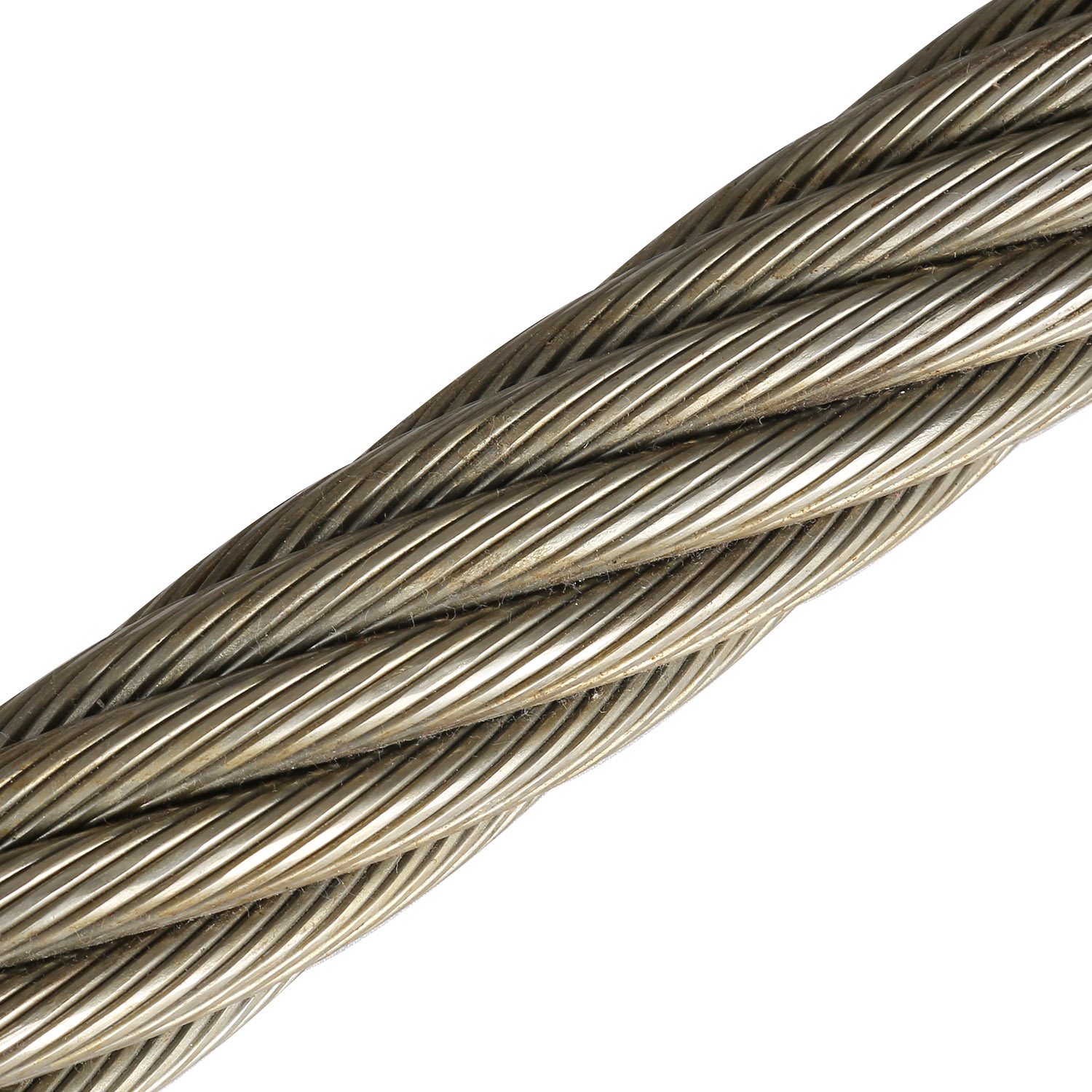Table of Contents
Benefits of Using Steel Wire Rope 3mm for Various Applications
Steel wire ropes are an essential component in various industries, providing strength and durability for a wide range of applications. One popular size of steel wire rope is the 3mm diameter, which offers a balance of strength and flexibility for many different uses. In this article, we will explore the benefits of using steel wire rope 3mm, as well as the advantages of open swage Socket wire rope and the importance of non-destructive testing for ensuring the Safety and reliability of steel wire ropes.
Steel wire rope 3mm is a versatile option that can be used in a variety of applications, from construction and mining to marine and transportation. Its small diameter makes it ideal for situations where space is limited, while still providing the strength and durability needed to handle heavy loads. The flexibility of 3mm steel wire rope allows for easy handling and installation, making it a popular choice for rigging and lifting operations.
One of the key advantages of steel wire rope 3mm is its high tensile strength, which allows it to withstand heavy loads without stretching or breaking. This makes it a reliable option for lifting and hoisting applications, where safety is paramount. The durability of 3mm steel wire rope also ensures a long service life, reducing the need for frequent replacements and maintenance.
In addition to its strength and durability, steel wire rope 3mm is also resistant to corrosion and abrasion, making it suitable for use in harsh environments. Whether exposed to saltwater, Chemicals, or extreme temperatures, 3mm steel wire rope can withstand the elements and maintain its performance over time. This makes it a cost-effective option for outdoor and marine applications, where other materials may deteriorate quickly.
Another important consideration when using steel wire rope is the type of end fitting or termination used. Open swage socket wire rope is a popular choice for securing the ends of steel wire ropes, providing a strong and reliable connection that can handle heavy loads. The open swage socket design allows for easy installation and removal of the wire rope, making it a versatile option for a variety of applications.
Non-destructive testing is an essential part of ensuring the safety and reliability of steel wire ropes. By using techniques such as magnetic particle inspection, ultrasonic testing, and visual inspection, potential defects and weaknesses in the wire rope can be identified before they Lead to failure. Regular non-destructive testing can help prevent accidents and injuries, as well as prolong the service life of steel wire ropes.
In conclusion, steel wire rope 3mm offers a range of benefits for various applications, including its strength, durability, and resistance to corrosion. When paired with open swage socket wire rope and regular non-destructive testing, steel wire ropes can provide a safe and reliable solution for lifting, rigging, and hoisting operations. Whether used in construction, mining, marine, or transportation, steel wire rope 3mm is a versatile option that can meet the demands of even the most challenging environments.
How to Properly Install an Open Swage Socket Wire Rope
Steel wire ropes are essential components in various industries, providing strength and durability for lifting, towing, and securing heavy loads. When it comes to installing steel wire ropes, proper techniques must be followed to ensure safety and efficiency. One common method of attaching a steel wire rope is using an open swage socket, which provides a secure connection between the rope and the attachment point. In this article, we will discuss how to properly install an open swage socket wire rope, as well as the importance of non-destructive testing to ensure the integrity of the rope.
Before beginning the installation process, it is crucial to gather all the necessary tools and equipment. This includes the open swage socket, wire rope, thimble, and appropriate tools for cutting and splicing the rope. It is also important to carefully inspect the wire rope for any signs of damage or wear, as using a compromised rope can lead to catastrophic failure.
To start the installation process, the wire rope must be properly measured and cut to the desired length. It is essential to use the correct tools for cutting the rope to prevent fraying or damage to the strands. Once the rope is cut to size, the next step is to insert the wire rope through the open swage socket and create a loop by passing the rope through a thimble.
After creating the loop, the next step is to secure the open swage socket to the wire rope. This is done by using a swaging tool to compress the socket onto the rope, creating a tight and secure connection. It is crucial to follow the manufacturer’s instructions for the swaging tool to ensure proper installation.
Once the open swage socket is securely attached to the wire rope, the final step is to conduct a non-destructive testing (NDT) of the assembly. NDT is a critical process that involves inspecting the wire rope for any defects or weaknesses that could compromise its integrity. This can be done using various methods such as visual inspection, magnetic particle testing, or ultrasonic testing.
Visual inspection involves examining the wire rope for any visible signs of damage, such as broken strands or corrosion. Magnetic particle testing is used to detect surface and near-surface defects in the wire rope by applying a magnetic field and inspecting for any indications of defects. Ultrasonic testing uses high-frequency sound waves to detect internal flaws in the wire rope, providing a comprehensive assessment of its condition.
By conducting NDT on the open swage socket wire rope, any potential issues can be identified and addressed before the rope is put into service. This helps to ensure the safety and reliability of the wire rope, reducing the risk of accidents or failures during operation.
In conclusion, proper installation of an open swage socket wire rope is essential for ensuring the safety and efficiency of lifting and securing heavy loads. By following the correct procedures and conducting non-destructive testing, the integrity of the wire rope can be maintained, providing peace of mind for operators and workers. Remember to always follow manufacturer guidelines and best practices when installing steel wire ropes to ensure optimal performance and safety.
Importance of Non-Destructive Testing for Steel Wire Ropes
Steel wire ropes are an essential component in various industries, including construction, mining, and transportation. These ropes are used for lifting heavy loads, supporting structures, and providing stability in various applications. Given the critical role that steel wire ropes play in ensuring safety and efficiency, it is crucial to ensure that they are in optimal condition. One way to achieve this is through non-destructive testing.
Non-destructive testing (NDT) is a method used to evaluate the integrity of materials and components without causing damage. In the case of steel wire ropes, NDT techniques are employed to detect defects, such as corrosion, wear, and fatigue, that could compromise the performance and safety of the ropes. By conducting regular NDT inspections, companies can identify potential issues early on and take corrective actions to prevent accidents and downtime.
One common NDT technique used for steel wire ropes is visual inspection. This involves visually examining the surface of the rope for signs of damage, such as broken wires, kinks, or rust. Visual inspection is a simple yet effective way to identify visible defects that could indicate more serious issues with the rope. In addition to visual inspection, other NDT methods, such as magnetic particle testing and ultrasonic testing, can be used to detect internal flaws that may not be visible to the naked eye.
Magnetic particle testing is a technique that uses magnetic fields to detect surface and near-surface defects in steel wire ropes. By applying a magnetic field to the rope and then applying magnetic particles, inspectors can identify cracks, inclusions, and other defects that could compromise the integrity of the rope. This method is particularly useful for detecting defects in areas that are difficult to access or inspect visually.
Ultrasonic testing is another NDT technique commonly used for steel wire ropes. This method involves sending high-frequency sound waves through the rope and measuring the time it takes for the waves to bounce back. By analyzing the reflected waves, inspectors can identify defects, such as internal corrosion, broken wires, and voids, that may be present in the rope. Ultrasonic testing is a non-invasive and accurate method for detecting defects in steel wire ropes.
In addition to detecting defects, NDT can also be used to assess the overall condition of steel wire ropes and determine their remaining service life. By conducting regular NDT inspections, companies can monitor the degradation of their ropes over time and make informed decisions about when to replace them. This proactive approach to maintenance can help prevent costly downtime and accidents caused by rope failure.
Overall, non-destructive testing plays a crucial role in ensuring the safety and reliability of steel wire ropes. By using NDT techniques to detect defects, assess the condition of ropes, and monitor their performance over time, companies can minimize the risk of accidents and downtime. Investing in regular NDT inspections is a cost-effective way to maintain the integrity of steel wire ropes and ensure their continued safe operation in various industrial applications.


